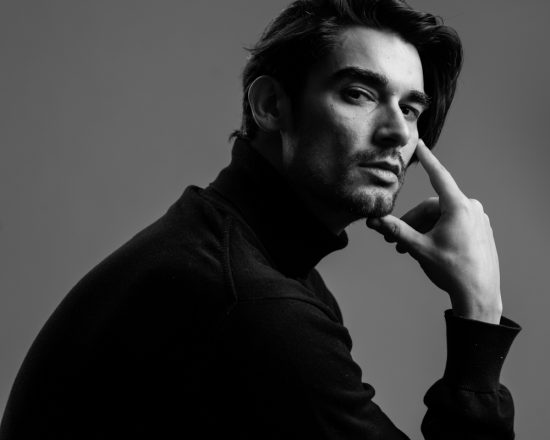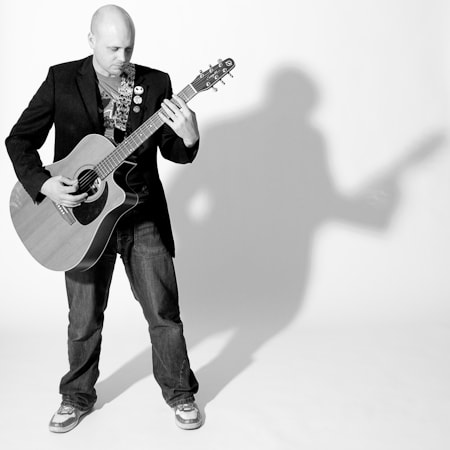How to Make a White Background Gray With Continuous Lighting
Our Studio Lighting Course covers all you need to know about creating a pure white background (as well as a whole host of other studio techniques), but this post should be enough to get you started.
A white background is incredibly versatile in the studio. It can be lit to be pure white, it can be a multitude of grey shades, or even black, and you can cast shadows onto it for added interest. Here are three examples:
Pure White Background

The above image is a good example of a pure white background. Our guitar player creates an interesting shape, and it's a nice high key, uplifting shot.
To get a pure white background you need to light the background so that is approximately 1.5 stops brighter than the main light that you are using to light your subject. This causes the background to overexpose and to show as pure white.
The lighting set up for this shot was as follows:
One light in a softbox, metered at f11 on the subject's face. Light placed camera left, so that the subject's face is pointing at the light source.
Two lights on the background, one on either side, using either reflectors or using barn doors to prevent spillage of light back onto the subject and stopping light going back towards the camera. i.e. directing all of the light towards the background, in a fairly broad spread of light.
The two background lights are metered so that the whole of the background measures somewhere between f16 and f22. We're aiming for 1.5 stops brighter than the subject (which is a f11), and you'll need to play around with the positioning of the two lights and their power setting to get a fairly even spread. Practice will show you the best positions for the light. Don't obsess about being exactly 1.5 stops brighter than the main light on the subject. The reading may be slightly different at the edges than in the middle, but as long as it's between one and two stops brighter, you should be OK.
The reason we try not to go much brighter than 1.5 stops is this – if it gets much brighter you'll start to see reflection of the background around the edges of your subject and it will start to merge into the general whiteness of the background. You'll loose definition around the edges of your subject, particularly around the face and neck.
You can minimise reflection from the background onto your subject by having your subject stand as far away from the background as possible. The further the better, try to get a minimum of 3 metres if possible, preferably more. If your subject is too close to the background, you will struggle to prevent light from reflecting onto your subject from the background. This can look a little messy and unprofessional.
Grey Background

In this picture the background is completely grey, yet we are using a white background. This is very simple to achieve. The lighting for this shot is as follows:
Just one light was used, in a softbox, placed directly to the left of the subject as we look at it. The light is coming directly from the side of the subject, who is standing around 3 metres away from the background. Therefore, not much light is hitting the background from the main light, which is the only light we are using. The result is a very grey background.
The background can be made lighter grey by moving the subject and the light closer to the background, or it can be made darker by moving everything further from the background. Simple really.
Background Shadow

Some interest can be added to you studio photography by creating a shadow on a white background. The above shot is lit with one light, pretty much directly in front and slightly above the subject.
The key to getting that 'rim' of shadow is to have your subject stand as close to the background as possible, maybe only a few inches away. It gives quite a nice effect and emphasises shape within the shot. You can experiment with harder and softer lights to give a harder or softer shadow, and also try moving your subject closer and further from the background.
Our Studio Lighting Course covers all you need to know about lighting backgrounds.
Source: https://www.36exp.co.uk/studio-lighting-techniques-for-a-white-background/
Belum ada Komentar untuk "How to Make a White Background Gray With Continuous Lighting"
Posting Komentar